Marin Oršić
Weakly supervised training of universal visual concepts for multi-domain semantic segmentation
Dec 20, 2022Abstract:Deep supervised models have an unprecedented capacity to absorb large quantities of training data. Hence, training on multiple datasets becomes a method of choice towards strong generalization in usual scenes and graceful performance degradation in edge cases. Unfortunately, different datasets often have incompatible labels. For instance, the Cityscapes road class subsumes all driving surfaces, while Vistas defines separate classes for road markings, manholes etc. Furthermore, many datasets have overlapping labels. For instance, pickups are labeled as trucks in VIPER, cars in Vistas, and vans in ADE20k. We address this challenge by considering labels as unions of universal visual concepts. This allows seamless and principled learning on multi-domain dataset collections without requiring any relabeling effort. Our method achieves competitive within-dataset and cross-dataset generalization, as well as ability to learn visual concepts which are not separately labeled in any of the training datasets. Experiments reveal competitive or state-of-the-art performance on two multi-domain dataset collections and on the WildDash 2 benchmark.
Panoptic SwiftNet: Pyramidal Fusion for Real-time Panoptic Segmentation
Mar 15, 2022



Abstract:Dense panoptic prediction is a key ingredient in many existing applications such as autonomous driving, automated warehouses or agri-robotics. However, most of these applications leverage the recovered dense semantics as an input to visual closed-loop control. Hence, practical deployments require real-time inference over large input resolutions on embedded hardware. These requirements call for computationally efficient approaches which deliver high accuracy with limited computational resources. We propose to achieve this goal by trading-off backbone capacity for multi-scale feature extraction. In comparison with contemporaneous approaches to panoptic segmentation, the main novelties of our method are scale-equivariant feature extraction and cross-scale upsampling through pyramidal fusion. Our best model achieves 55.9% PQ on Cityscapes val at 60 FPS on full resolution 2MPx images and RTX3090 with FP16 Tensor RT optimization.
Multi-domain semantic segmentation with overlapping labels
Aug 25, 2021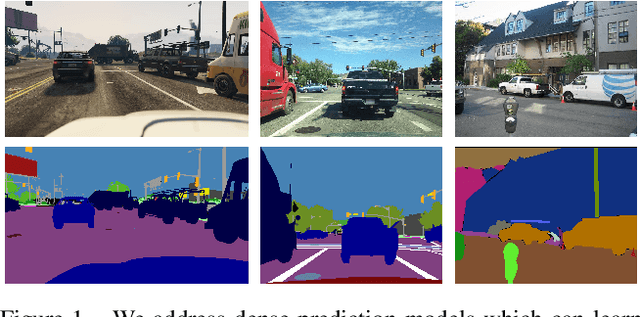


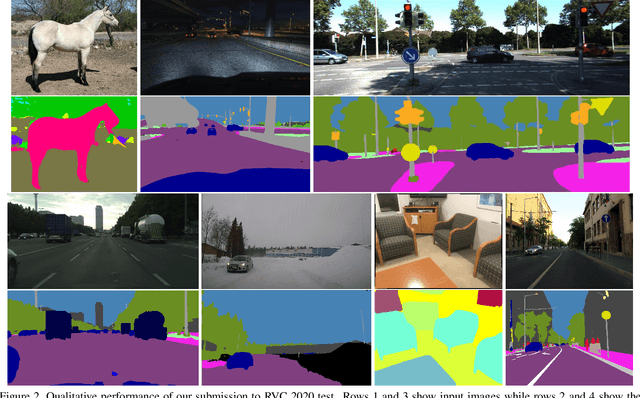
Abstract:Deep supervised models have an unprecedented capacity to absorb large quantities of training data. Hence, training on many datasets becomes a method of choice towards graceful degradation in unusual scenes. Unfortunately, different datasets often use incompatible labels. For instance, the Cityscapes road class subsumes all driving surfaces, while Vistas defines separate classes for road markings, manholes etc. We address this challenge by proposing a principled method for seamless learning on datasets with overlapping classes based on partial labels and probabilistic loss. Our method achieves competitive within-dataset and cross-dataset generalization, as well as ability to learn visual concepts which are not separately labeled in any of the training datasets. Experiments reveal competitive or state-of-the-art performance on two multi-domain dataset collections and on the WildDash 2 benchmark.
A baseline for semi-supervised learning of efficient semantic segmentation models
Jun 15, 2021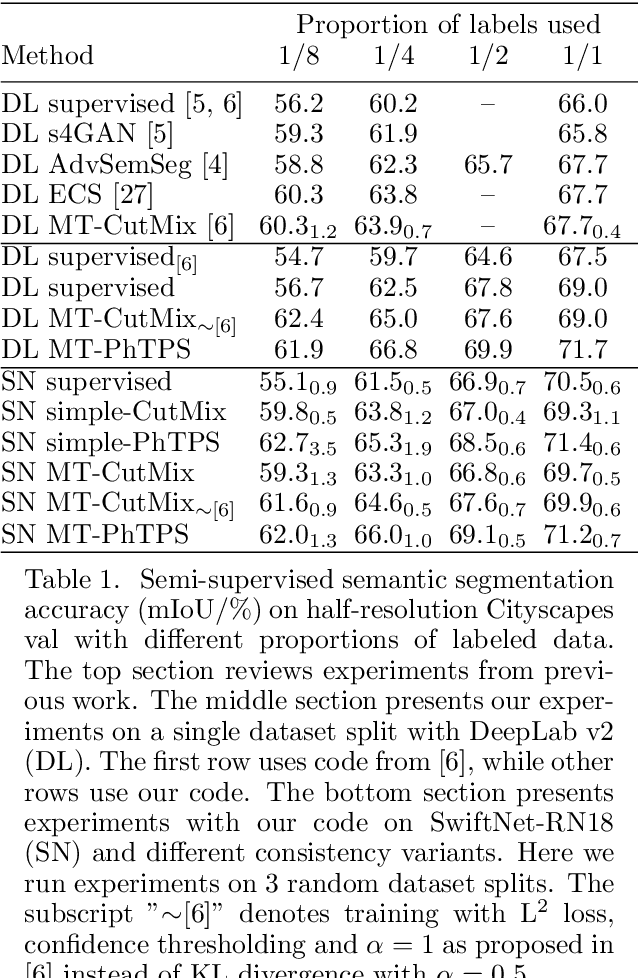
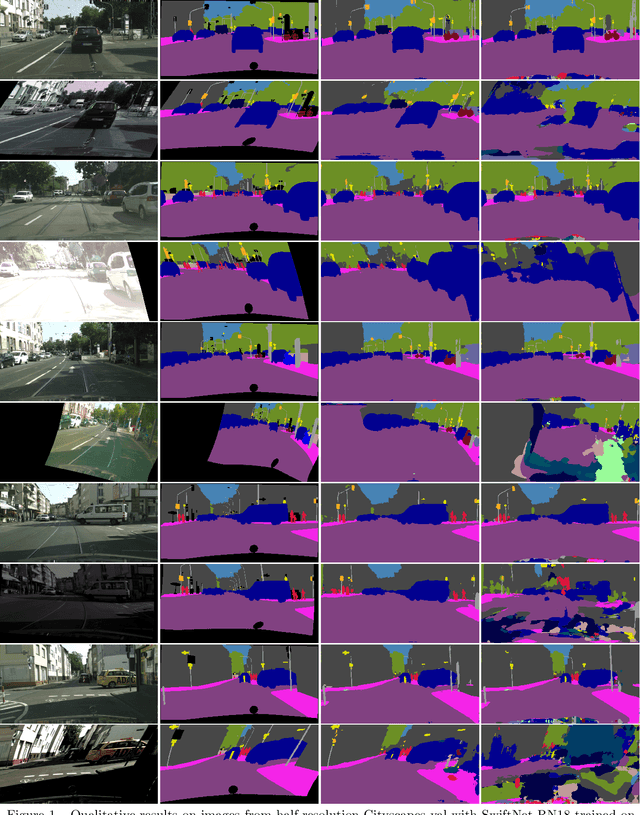
Abstract:Semi-supervised learning is especially interesting in the dense prediction context due to high cost of pixel-level ground truth. Unfortunately, most such approaches are evaluated on outdated architectures which hamper research due to very slow training and high requirements on GPU RAM. We address this concern by presenting a simple and effective baseline which works very well both on standard and efficient architectures. Our baseline is based on one-way consistency and non-linear geometric and photometric perturbations. We show advantage of perturbing only the student branch and present a plausible explanation of such behaviour. Experiments on Cityscapes and CIFAR-10 demonstrate competitive performance with respect to prior work.
Dense outlier detection and open-set recognition based on training with noisy negative images
Jan 22, 2021
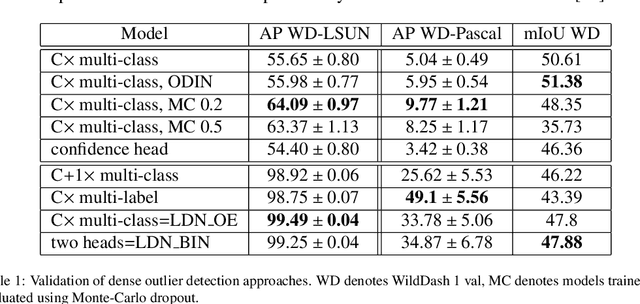
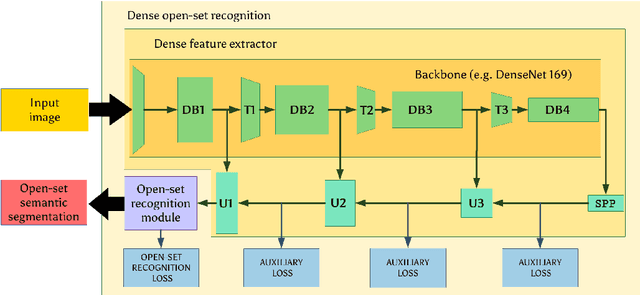
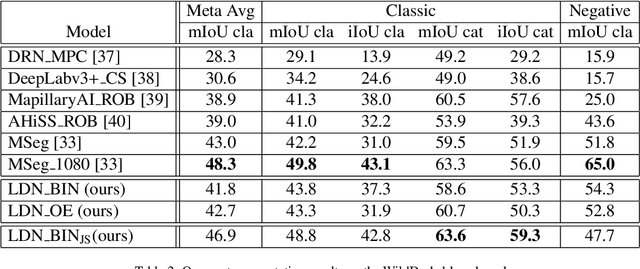
Abstract:Deep convolutional models often produce inadequate predictions for inputs foreign to the training distribution. Consequently, the problem of detecting outlier images has recently been receiving a lot of attention. Unlike most previous work, we address this problem in the dense prediction context in order to be able to locate outlier objects in front of in-distribution background. Our approach is based on two reasonable assumptions. First, we assume that the inlier dataset is related to some narrow application field (e.g.~road driving). Second, we assume that there exists a general-purpose dataset which is much more diverse than the inlier dataset (e.g.~ImageNet-1k). We consider pixels from the general-purpose dataset as noisy negative training samples since most (but not all) of them are outliers. We encourage the model to recognize borders between known and unknown by pasting jittered negative patches over inlier training images. Our experiments target two dense open-set recognition benchmarks (WildDash 1 and Fishyscapes) and one dense open-set recognition dataset (StreetHazard). Extensive performance evaluation indicates competitive potential of the proposed approach.
Multi-domain semantic segmentation with pyramidal fusion
Sep 16, 2020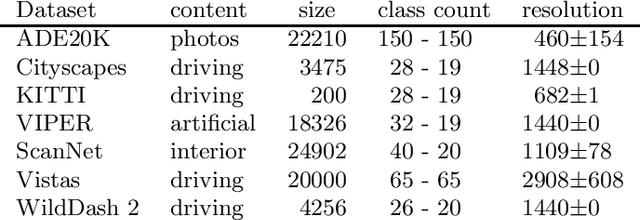


Abstract:We present our submission to the semantic segmentation contest of the Robust Vision Challenge held at ECCV 2020. The contest requires submitting the same model to seven benchmarks from three different domains. Our approach is based on the SwiftNet architecture with pyramidal fusion. We address inconsistent taxonomies with a single-level 193-dimensional softmax output. We strive to train with large batches in order to stabilize optimization of a hard recognition problem, and to favour smooth evolution of batchnorm statistics. We achieve this by implementing a custom backward step through log-sum-prob loss, and by using small crops before freezing the population statistics. Our model ranks first on the RVC semantic segmentation challenge as well as on the WildDash 2 leaderboard. This suggests that pyramidal fusion is competitive not only for efficient inference with lightweight backbones, but also in large-scale setups for multi-domain application.
Simultaneous Semantic Segmentation and Outlier Detection in Presence of Domain Shift
Aug 03, 2019
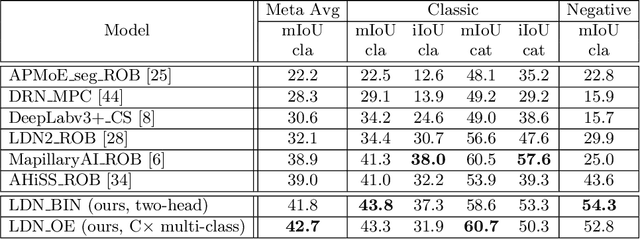
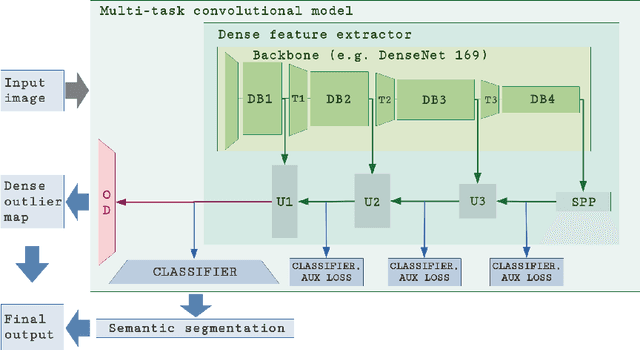

Abstract:Recent success on realistic road driving datasets has increased interest in exploring robust performance in real-world applications. One of the major unsolved problems is to identify image content which can not be reliably recognized with a given inference engine. We therefore study approaches to recover a dense outlier map alongside the primary task with a single forward pass, by relying on shared convolutional features. We consider semantic segmentation as the primary task and perform extensive validation on WildDash val (inliers), LSUN val (outliers), and pasted objects from Pascal VOC 2007 (outliers). We achieve the best validation performance by training to discriminate inliers from pasted ImageNet-1k content, even though ImageNet-1k contains many road-driving pixels, and, at least nominally, fails to account for the full diversity of the visual world. The proposed two-head model performs comparably to the C-way multi-class model trained to predict uniform distribution in outliers, while outperforming several other validated approaches. We evaluate our best two models on the WildDash test dataset and set a new state of the art on the WildDash benchmark.
Single Level Feature-to-Feature Forecasting with Deformable Convolutions
Jul 26, 2019



Abstract:Future anticipation is of vital importance in autonomous driving and other decision-making systems. We present a method to anticipate semantic segmentation of future frames in driving scenarios based on feature-to-feature forecasting. Our method is based on a semantic segmentation model without lateral connections within the upsampling path. Such design ensures that the forecasting addresses only the most abstract features on a very coarse resolution. We further propose to express feature-to-feature forecasting with deformable convolutions. This increases the modelling power due to being able to represent different motion patterns within a single feature map. Experiments show that our models with deformable convolutions outperform their regular and dilated counterparts while minimally increasing the number of parameters. Our method achieves state of the art performance on the Cityscapes validation set when forecasting nine timesteps into the future.
Pedestrian Tracking by Probabilistic Data Association and Correspondence Embeddings
Jul 16, 2019



Abstract:This paper studies the interplay between kinematics (position and velocity) and appearance cues for establishing correspondences in multi-target pedestrian tracking. We investigate tracking-by-detection approaches based on a deep learning detector, joint integrated probabilistic data association (JIPDA), and appearance-based tracking of deep correspondence embeddings. We first addressed the fixed-camera setup by fine-tuning a convolutional detector for accurate pedestrian detection and combining it with kinematic-only JIPDA. The resulting submission ranked first on the 3DMOT2015 benchmark. However, in sequences with a moving camera and unknown ego-motion, we achieved the best results by replacing kinematic cues with global nearest neighbor tracking of deep correspondence embeddings. We trained the embeddings by fine-tuning features from the second block of ResNet-18 using angular loss extended by a margin term. We note that integrating deep correspondence embeddings directly in JIPDA did not bring significant improvement. It appears that geometry of deep correspondence embeddings for soft data association needs further investigation in order to obtain the best from both worlds.
In Defense of Pre-trained ImageNet Architectures for Real-time Semantic Segmentation of Road-driving Images
Apr 12, 2019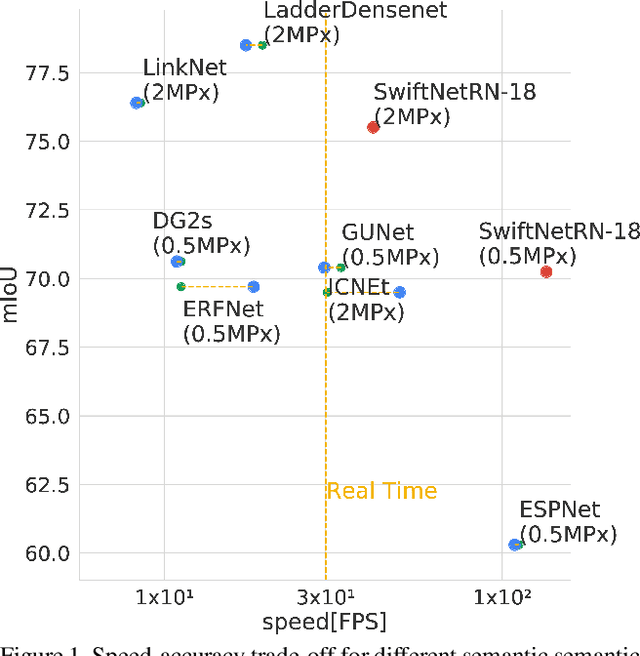
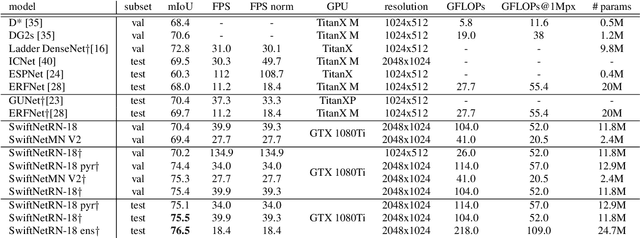

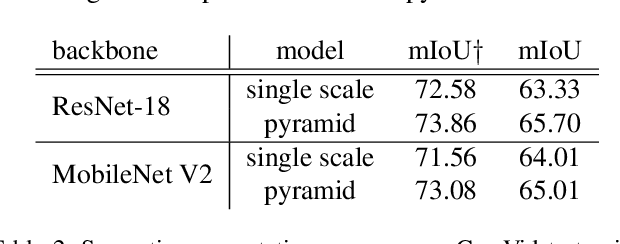
Abstract:Recent success of semantic segmentation approaches on demanding road driving datasets has spurred interest in many related application fields. Many of these applications involve real-time prediction on mobile platforms such as cars, drones and various kinds of robots. Real-time setup is challenging due to extraordinary computational complexity involved. Many previous works address the challenge with custom lightweight architectures which decrease computational complexity by reducing depth, width and layer capacity with respect to general purpose architectures. We propose an alternative approach which achieves a significantly better performance across a wide range of computing budgets. First, we rely on a light-weight general purpose architecture as the main recognition engine. Then, we leverage light-weight upsampling with lateral connections as the most cost-effective solution to restore the prediction resolution. Finally, we propose to enlarge the receptive field by fusing shared features at multiple resolutions in a novel fashion. Experiments on several road driving datasets show a substantial advantage of the proposed approach, either with ImageNet pre-trained parameters or when we learn from scratch. Our Cityscapes test submission entitled SwiftNetRN-18 delivers 75.5% MIoU and achieves 39.9 Hz on 1024x2048 images on GTX1080Ti.
 Add to Chrome
Add to Chrome Add to Firefox
Add to Firefox Add to Edge
Add to Edge